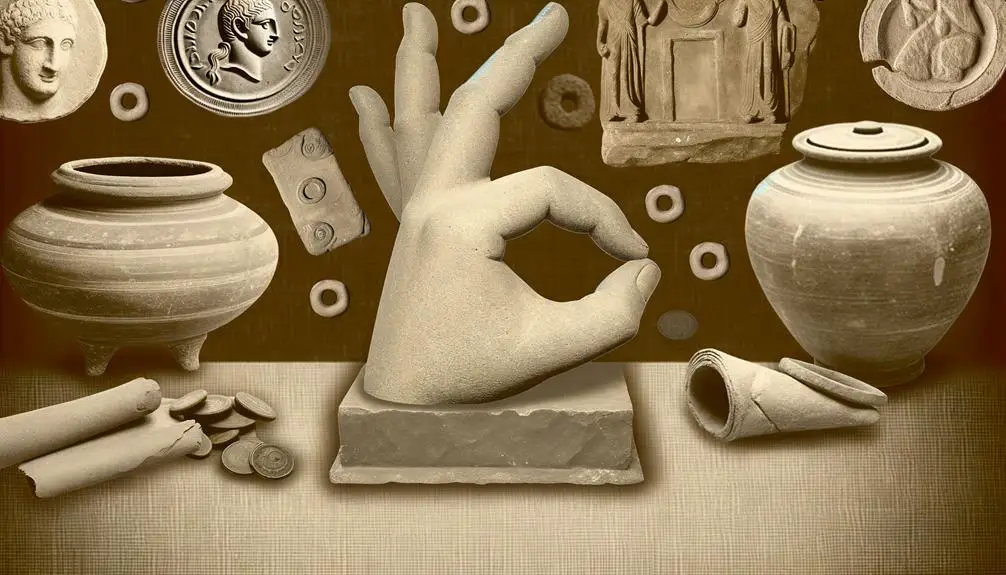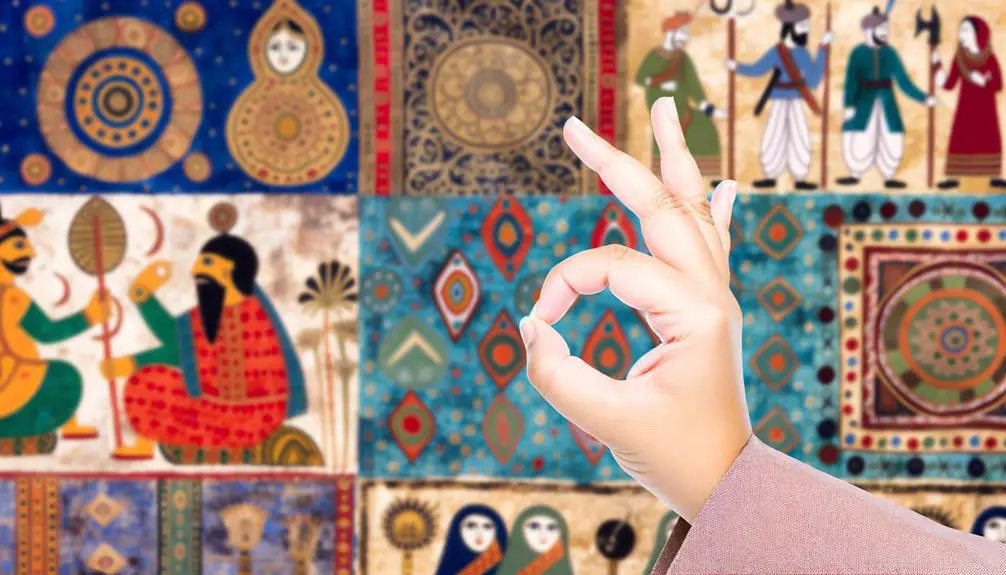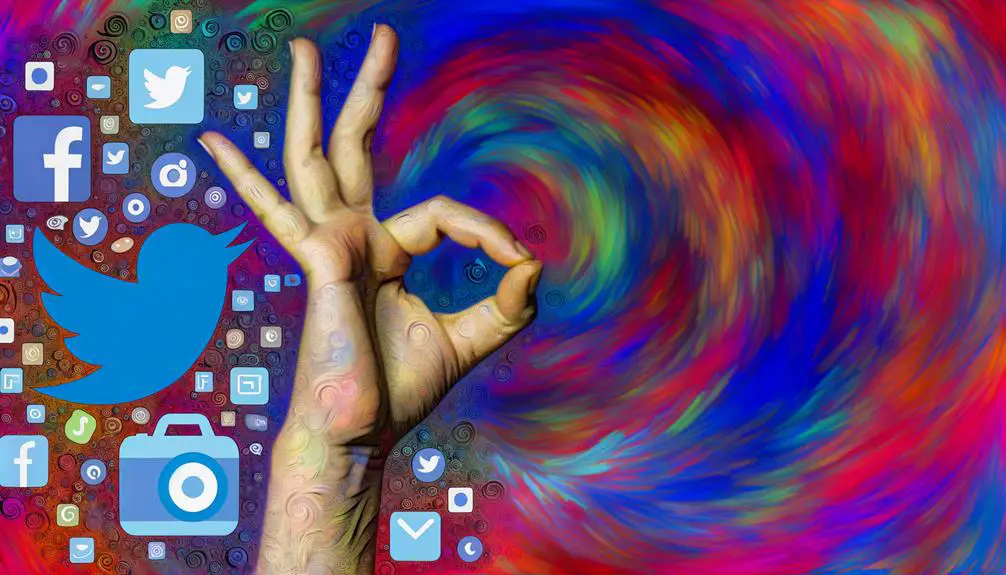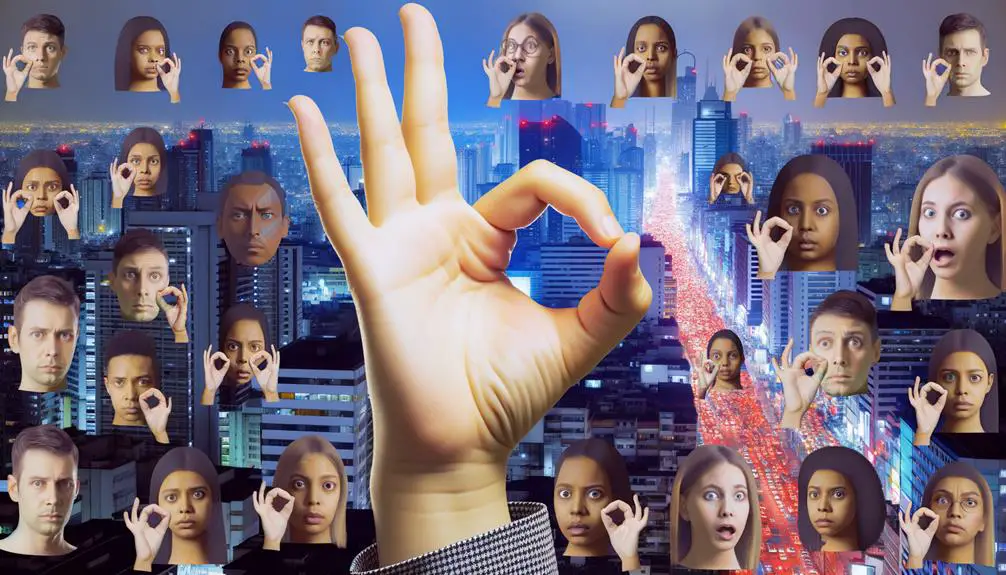What is the Meaning of the OK Symbol in Urban Dictionary?
The 'OK' symbol, historically emerging from 19th-century American culture as 'oll korrect,' signifies approval and affirmation. Traditionally used to denote agreement, its meaning varies globally: symbolizing money in Japan and considered offensive in Brazil.
In digital contexts, Urban Dictionary documents its diverse interpretations, including newer, internet-influenced connotations. Scholars must observe these evolving meanings for accurate digital communication analysis.
While typically a positive gesture, understanding its multifaceted uses and cultural nuances is pivotal for effective non-verbal interaction. For a deeper understanding, consider exploring its cultural variations and recent internet slang evolution.
Key Takeaways
- The 'OK' symbol on Urban Dictionary often references its use in internet slang and memes.
- It can signify agreement, approval, or acknowledgment in casual online communication.
- The 'OK' symbol may also have controversial interpretations in certain internet subcultures.
- Understanding its context is crucial as the meaning can shift rapidly on digital platforms.
- It remains a versatile gesture with both positive and potentially negative connotations online.
Historical Origins

The 'OK' symbol, historically rooted in 19th-century American culture, initially emerged as a playful abbreviation for 'oll korrect,' a humorous misspelling of 'all correct.' This linguistic jest gained traction in the early 1840s, coinciding with a period of American fascination with quirky abbreviations and wordplay.
The term garnered widespread popularity through its adoption in political campaign slogans, especially by President Martin Van Buren, nicknamed 'Old Kinderhook.' The symbol itself, formed by connecting the thumb and index finger into a circle while other fingers extend, visually reinforced the verbal expression of affirmation and approval.
This confluence of written and gestural communication solidified 'OK' as a versatile and enduring element of American vernacular. Understanding its origins provides insight into its enduring ubiquity.
Traditional Interpretations

Beyond its historical origins, traditional interpretations of the 'OK' symbol have consistently recognized it as a universal gesture of assent, affirmation, and positive acknowledgment. This hand gesture, formed by connecting the thumb and index finger into a circle while extending the other fingers, has been widely understood in various contexts to signify agreement or approval.
| Context | Interpretation |
|---|---|
| Conversation | Agreement or understanding |
| Sports | Signal of success or goal |
| Business | Confirmation or approval |
The symbol's semantic implications are deeply embedded in everyday communication, providing a non-verbal cue that transcends language barriers. Its usage in professional, social, and casual interactions underscores its role as a versatile and universally comprehensible sign of positive reception.
Cultural Variations
Although the 'OK' symbol is widely recognized for its positive connotations, its meaning can vary greatly across different cultural contexts. In Western societies, the gesture typically signifies agreement or approval.
However, in some Mediterranean countries such as Greece and Turkey, the same gesture can be offensive, resembling a vulgar anatomical reference. In Japan, it can represent money, while in Brazil, it is considered highly disrespectful.
These cultural variations underscore the importance of understanding non-verbal communication within specific social frameworks. Misinterpretation of gestures can lead to significant misunderstandings, highlighting the necessity for cultural sensitivity.
The 'OK' symbol serves as an exemplar of how gestures are subject to diverse interpretations, contingent upon regional and cultural norms.
Internet Slang Evolution

The evolution of internet slang is characterized by the rapid emergence of new terms and shifting interpretations of existing symbols, such as the 'OK' hand gesture.
This dynamic linguistic landscape is influenced by the interplay of digital communication platforms and cultural contexts.
Consequently, understanding the fluidity of internet slang necessitates an analysis of both contemporary and historical usage patterns.
Emergence of New Terms
Internet slang evolution exemplifies the dynamic nature of language. New terms like 'OK symbol' rapidly emerge and gain distinct connotations through online interactions. This phenomenon can be attributed to the adaptive and fluid nature of digital communication environments.
In these spaces, users continuously innovate language to express complex ideas, emotions, and social identities concisely. The 'OK symbol,' initially a benign hand gesture, has undergone significant semantic shifts, illustrating how symbols can be co-opted and redefined within internet subcultures.
This continuous emergence of new terms necessitates a thorough understanding of contextual usage and the underlying social dynamics driving these linguistic transformations. Consequently, scholars and practitioners must remain vigilant in tracking these evolving vernaculars to accurately interpret contemporary digital dialogues.
Shifting Symbol Interpretations
How has the 'OK symbol' evolved from a simple gesture to a complex socio-political emblem within digital communication landscapes?
Historically, the 'OK symbol' was universally understood as a positive affirmation. However, the digital age has transformed its interpretation through various socio-political lenses.
This evolution can be attributed to:
- Meme Culture: Internet memes have recontextualized the symbol, often imbuing it with sarcastic or subversive meanings.
- Political Appropriation: Certain groups have co-opted the gesture, altering its perception as a symbol of hate.
- Media Amplification: Social and news media platforms have disseminated these new interpretations widely.
- Contextual Variability: The symbol's meaning now often depends on the specific digital or cultural context in which it is used.
These shifts underscore the dynamic nature of symbol interpretations in online communication.
Positive Connotations

The 'OK' symbol, often represented by forming a circle with the thumb and index finger, historically carries positive connotations in various contexts.
It functions as a friendly communication gesture, signaling social media approval and indicating agreement or affirmation.
Understanding these positive interpretations enhances our grasp of its multifaceted usage in contemporary digital interactions.
Friendly Communication Gesture
Widely recognized as a symbol of agreement or approval, the 'OK' gesture often serves as a friendly and positive form of nonverbal communication. This ubiquitous hand gesture, made by forming a circle with the thumb and index finger while extending the other fingers, transcends linguistic barriers and is understood globally.
Its utilization spans various contexts, enhancing interpersonal interactions through:
- Affirmation: Indicating consent or understanding.
- Encouragement: Offering support or reassurance.
- Congratulatory: Celebrating achievements or milestones.
- Casual Interaction: Facilitating informal, friendly exchanges.
Such diverse applications underscore its role in fostering amicable and effective communication. The 'OK' gesture's versatility makes it an invaluable tool in both personal and professional settings, promoting clarity and goodwill among individuals.
Social Media Approval
Across various social media platforms, the 'OK' gesture often signifies approval, validation, and positive reinforcement. This symbol, when employed in digital interactions, serves as a shorthand for acknowledging content favorably, whether it be a post, comment, or media.
The gesture encapsulates a succinct form of digital commendation, reflecting a user's endorsement or satisfaction with the shared material. In contexts where brevity and immediacy are paramount, the 'OK' symbol efficiently communicates a positive response, fostering a culture of encouragement.
Additionally, its versatility spans across diverse social media environments, making it a ubiquitous tool for instant positive feedback. Consequently, this emblem has become a staple in the lexicon of online interactions, underpinning user engagement and community building.
Agreement and Affirmation
Building on its role in social media approval, the 'OK' symbol also serves as a powerful visual cue for agreement and affirmation, embodying positive connotations in various communicative contexts.
This symbol is employed across diverse settings to signify concurrence, validation, and mutual understanding. Specifically, it is used in:
- Professional meetings: Indicating consensus or approval of ideas.
- Educational environments: Affirming understanding or correct answers.
- Daily interactions: Conveying agreement in casual conversations.
- Global communication: Bridging language barriers by universally recognized gesture.
The 'OK' symbol's versatility in expressing positive affirmation underscores its relevance in enhancing constructive discourse. By fostering a sense of mutual agreement, it effectively aids in the seamless exchange of ideas and intentions.
Controversial Associations

The 'OK' symbol, traditionally a gesture signifying approval or agreement, has become embroiled in controversy due to its appropriation by certain extremist groups as a symbol of white supremacy.
This co-optation began as a hoax but evolved into an authentic symbol within hate groups, altering its public perception to a great extent. The Anti-Defamation League (ADL) has cataloged this gesture under hate symbols, recognizing its potential to convey covert racist intentions.
This dual usage complicates its interpretation in social contexts, leading to increased scrutiny and misunderstanding. The transformation of the 'OK' symbol into a contentious emblem exemplifies the broader phenomena of innocuous symbols being repurposed with harmful connotations, necessitating a cautious and informed approach to its use and interpretation.
Social Media Influence

In the world of social media, the 'OK' symbol's controversial reinterpretation has been both amplified and disseminated at an unprecedented rate, profoundly influencing public discourse and perception. Platforms such as Twitter, Facebook, and Instagram have played pivotal roles in this phenomenon.
Key aspects of social media influence include:
- Virality: The rapid spread of images and memes associated with the 'OK' symbol.
- Echo Chambers: The reinforcement of specific interpretations within online communities.
- Algorithmic Amplification: The prioritization of contentious content by social media algorithms.
- User-Generated Content: The proliferation of personal interpretations and reactions.
These factors collectively underscore the transformative power of social media in shaping the contemporary understanding and connotations of the 'OK' symbol.
Misinterpretations and Misunderstandings

Despite its innocuous origins, the 'OK' symbol has become a subject of significant misinterpretations and misunderstandings, often inciting polarized reactions. Originally a benign gesture signifying agreement or well-being, its appropriation by various groups has led to divergent interpretations.
For instance, in some contexts, it has been co-opted by extremist factions as a symbol of hate, leading to its stigmatization. This recontextualization has created a landscape where the symbol's meaning varies dramatically depending on the audience and situational context.
Consequently, its use can inadvertently provoke controversy, reflecting broader societal tensions and the complexities of symbolic communication. Understanding these nuances is critical in navigating the potential pitfalls surrounding the 'OK' symbol in contemporary discourse.
Ongoing Debates

Scholarly discourse surrounding the 'OK' symbol remains contentious, with ongoing debates focusing on its evolving significance and the implications of its varied interpretations. Central to these discussions are concerns about the symbol's association with diverse meanings.
Researchers and cultural analysts have identified several key areas of debate:
- Historical Context: Examining the symbol's origins and how its meaning has changed over time.
- Cultural Appropriation: Investigating how different groups have adopted and adapted the symbol.
- Semiotic Shifts: Analyzing the transformation of the symbol's meaning in various social contexts.
- Impact of Digital Media: Evaluating the role of online platforms in propagating new interpretations.
These debates underscore the complexity of deciphering symbols within dynamic sociocultural landscapes.
Conclusion
The convergence of historical origins, traditional interpretations, and cultural variations with the evolution of internet slang has resulted in the multifaceted symbolism of the 'OK' symbol.
This symbol's trajectory from positive connotations to controversial associations underscores its complex semiotic landscape.
Coincidentally, the pervasive influence of social media has amplified both its celebratory and contentious uses, fueling ongoing debates and frequent misinterpretations.
This phenomenon underscores the intricate interplay between digital culture and socio-linguistic evolution.





